Mattel – Hot Wheels
Posted in: UncategorizedCredits:
Ad agency: Ogilvy, London. UK
Creative Director: Alasdair Graham
Head Of Art: Andy Bird
Copywriter: Jason Mendes. Andy Wyton
Art Director: Andy Wyton. Jason Mendes
Account Manager: Leah Walsh
Account Supervisor: Kate Dowling
Photographer: Chris Jelley. Photolibrary.
Agency Producer: Mark Doyle.
Retoucher: Trevor Qizilbash @ Tag
Art Buyer: Coral Stafford. Brigette Martin
Country: UK
Rolling Stone: “Light blue”, “Yellow”,” Purple”
Posted in: UncategorizedNintendo WII – Disaster
Posted in: UncategorizedCredits:
Client: NINTENDO FRANCE
Product: DISASTER WII
Title: JUST SURVIVE
Advertising Agency: ALERTE ORANGE / PARIS / FRANCE
Executive Creative Director: OLIVIER BODEUR
Creative Directors: PHILIPPE VALLET
Art Director: Christopher Hittinger
Photographer: PATRICK CANNINGHER
Digital Retouch: PHILIPPE VALLET / CHRISTOPHE HITTINGER
Nintendo DS
Posted in: UncategorizedTV idents
Posted in: UncategorizedSofa Experience, the new director’s team from Agosto filmed a series of idents to promote the art&culture TV program SILENCI?
1 – Danko
2 – Danko’s book
3 – I don’t wanna grow up
Wrangler – we are animals advertising campaign
Posted in: UncategorizedIt has been quite some time since I did wrote on this advert blog but honestly I do not like much the latest ads posted by creative firms of the world. Not much too see on the new campaigns, few of them have good messages.
The only one new that I saw today was the Wrangler FLARE ad prints campaign and the related spot called “Animals”.
The new print campaign from FFL Paris for Wrangler illustrates humans as animals in different locations in the wild.
The Wrangler brand is repositioning itself through instinct and emotion.




The spot we are animals.
From The Press Release
In today’s society, our animal instincts are smothered by daily modern life, city-living and constant technological developments. Man is an animal, but he no longer knows it.
Wrangler’s new strategic and creative platform seeks to re-awaken our bottled-up instincts and to encourage who and what we fundamentally are, by putting all that is pure, natural and instinctive back into Man.
Agency: FFL Paris
Executive Creative Director: Fred & Farid
Art Director: Julie Louison, Perinne Durand
Copywriter: Julie Louison, Perinne Durand
Agency Supervisor: Fred & Farid, Daniel Dormeyer, Brani Branitcheva, Vassilios Basos, Paola Bersi
Advertiser Supervisor: Giorgio Presca, Mark Cuthbert, Gary Burnand, Carmen Claes
Art Buyer: Camille Guerrier, Charlotte Delobelle
Media Strategy and Buying: FFL Media, Pascal Crifo
Interactivos? workshop: Immodesty multicam system
Posted in: UncategorizedBack to the latest Interactivos? at Medialab Prado in Madrid. Subtitled Vision Play, this edition offered artists and other creative people the opportunity to create prototypes for exploring image technologies and mechanisms of perception, using open hardware and open code tools.
When it comes to exploring image technologies in a striking and poetical way, i’d say that Karolina Sobeka is certainly one of the most talented artists i’ve ever met. A couple of years ago, she developed the mesmerizing wildlife backseat projection which she showed in several countries. This time she was in Madrid to bring into being the Immodesty project.
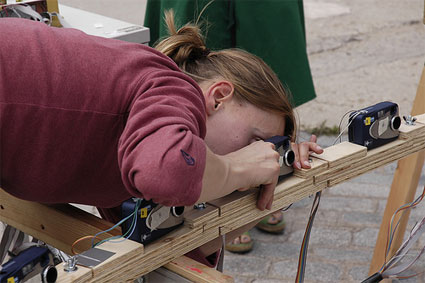
Image courtesy of Emanuel from tagr.tv
This system is a prototype for a portable image recording system based on cheap, disposable multiple cameras positioned along a path. Controlled by a microcontroller, each camera can be assigned an individual time delay.
The aim of the project was to create an affordable platform which enable all kinds of temporal-spatial experimentation. Their first prototype for example, tried to re-conceive or visualize a spatial perception which expands the body’s point of view in space. Check out the videos on the project website to get a clearer idea of what the project is about.
What was the inspiration the Immodesty project? How did you come up with that idea?
My background is in animation and video, and I’ve always been interested in making videos whose structure is manipulated at a very basic level, frame by frame, and that say something about our perception of time or space or point of view. These three elements are normally linked as the camera simulates our experience of visual perception. If we disassociate them, we can step outside this experience and maybe ‘cheat’ the laws of physics. There is something magical about seeing physical reality from a point of view that this reality precludes.
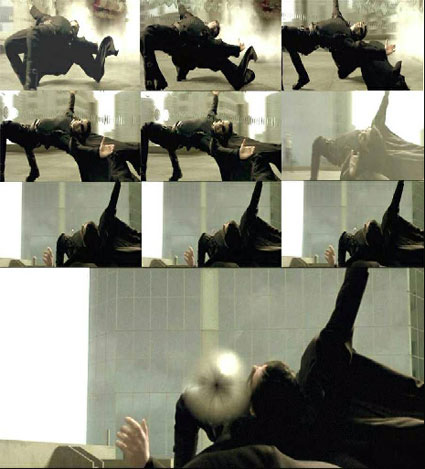
Screenshots from The Matrix (image the raw feed)
The kinds of videos I wanted to make would call for the multi-lens camera set-ups (which do exist — and which were made famous by the bullet time effect from Matrix — but are very out of financial reach for an independent artist). So when I had an idea for a video that would require a fast and long vertical movement of the camera, Interactivos? call came along for ‘Vision Play’ projects. During the workshop I wanted to create a reconfigurable recording system, which could be used to create many different kinds of content, a tool for artists to experiment with, as well as to demonstrate one kind of recording paired with one kind of display. Since I’ve been interested in the viewer’s interaction with an image and in the bodily experience of space, I ended up going with recording moments in time from multiple points of view, and building narrative with them. The narrative would unfold as the viewer explored these moments by moving through space. The change in perspective gives the viewer new information about the scene she’s watching. It is a similar experience as when you walk by an open door and only see a fragment of the scene at a time. Your movement reveals the space and the story. When you come back to the doorway the scene is different, the story has advanced. In the installation the viewer would be able to approach the story from either direction, and once she’s seen the entire ‘moment’, a new one will be loaded that shows another moment in the same story.
I think this is a nice metaphor for the scope of our attention, always moving from detail to detail to sequence them together in a sense-making pattern.
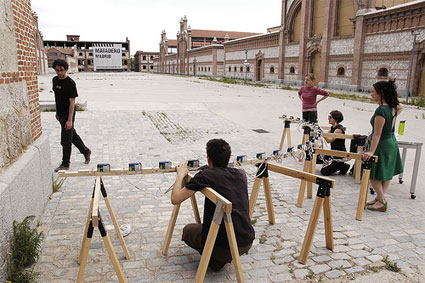 height=”283″ class=”mt-image-none” style=”” />
height=”283″ class=”mt-image-none” style=”” />
Image courtesy of Emanuel from tagr.tv
Immodesty seems to be very complex from the technology point of view. Which kind of challenge did you encounter while developing it and how did you overcome them? Did the difficulties make you modify any aspect of the project?
In a way the technology to make it possible existed already when Eadweard Muybridge was arranging his cameras sequentially along the path and triggering the shutters — the complex part is turning it into a portable, modular system that’s affordable and easy to experiment with. For a while the biggest challenge to creating a system like this was the expense of technology, but today the prices of cameras are dropping, it’s conceivable to use lots of them for one project, and it is possible to imagine it as a tool for experimentation. The cameras are also getting smaller and lighter, which make it possible to make a portable rig and to manipulate and position the cameras more freely.
This project posed many challenges, for example designing and building a modular reconfigurable rig, that would at the same time provide the rigidity and near-perfect alignment for the cameras. We ended up creating a wooden module for each camera that could be angled independently in the horizontal plane and that still allowed the cameras to be tilted and adjusted by hand. Most challenges were overcome after a lot of head-scratching thanks to the great help of the awesome collaborators and instructors at the workshop. One problem however that we couldn’t go around was the inconsistency in the time delay between the triggering of the shutter and the camera capturing an image, which made impossible the precision necessary for achieving some nice time effects. For the next version of the project I’m planning to use different cameras, hopefully solving this problem. This time we used the Dakota disposable digital cameras, the least expensive option, and which I liked because of utilizing the hack developed for these cameras when they came out, though it might have proved to be more of a trouble than benefit.
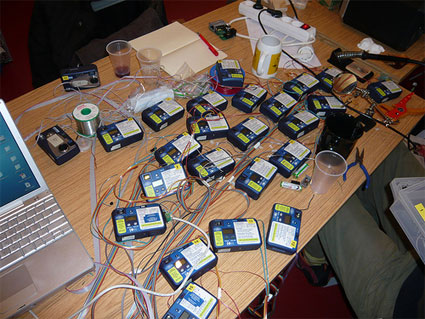
Image courtesy of Emanuel from tagr.tv
Creating the interactive display also posed some challenges. We had barely any time to put the installation together and could barely give enough consideration to the spatial arrangement, and to making sure that the size of the image and change in the projection felt correct in relationship to the viewer’s movement.
The project plays with spatio- temporal situations. Can you describe the kind of experimentation the multi camera system can give life to? Did any application emerge over the course of the development that you had not thought about before?
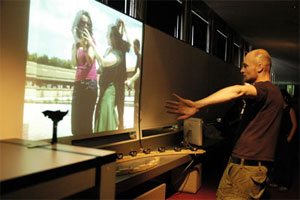 I think it would be interesting to record things impossible to experience physically: extremely slowed-down time flow while the movement in space is fast, or camera movement in the ‘frozen instant’ combined with a display in a ‘augmented reality’ system. For example I would like to create a spherical rig to record spherical video (the cameras would all be triggered at the same time and the images stitched into a large spherical map) that could be explored in a custom interactive display. It could be used for exploring movement and perception not possible through our physical bodies: for example my initial idea to create the vertical camera movement, in a video shot from a point of view of someone who is jumping higher and higher, way beyond human capabilities. I can also imagine it being used as a ‘wearable’ recording system, lightweight enough that it could be carried around while recording.
I think it would be interesting to record things impossible to experience physically: extremely slowed-down time flow while the movement in space is fast, or camera movement in the ‘frozen instant’ combined with a display in a ‘augmented reality’ system. For example I would like to create a spherical rig to record spherical video (the cameras would all be triggered at the same time and the images stitched into a large spherical map) that could be explored in a custom interactive display. It could be used for exploring movement and perception not possible through our physical bodies: for example my initial idea to create the vertical camera movement, in a video shot from a point of view of someone who is jumping higher and higher, way beyond human capabilities. I can also imagine it being used as a ‘wearable’ recording system, lightweight enough that it could be carried around while recording.
Many people brought many different ideas to this project — from an architectural point of view it could be used to create ‘virtual spaces’ or ‘expanded screen’. Someone working with stereo imagery, like Alvaro, would be interested in creating stereo videos using parallel camera paths. It could serve as a kind of a ‘total view’ mirror.
Several ideas came up also for using it interactively and hopefully we’ll be making some of them real soon!
Do you plan to develop the project any further?
Yes, definitely. What we developed at Interactivos? was a very imperfect prototype, which demonstrated only one simple application. There is definitely plenty of room for improvement and for taking it into many different directions. I’m planning to use different cameras that will allow more flexibility: automatic download or even real time image capture, perhaps video recording capability, etc. Hopefully we’ll be able to bring to life some of the ideas that came up during Interactivos? and I’ll be able to create more videos and installations.
I’m definitely open to any ideas people might have for using it, and once we have our second prototype that’s a little more stable it would be great to make it available for different kinds of projects.
Thanks Karolina!
World of World of Warcraft
Posted in: UncategorizedPainfully funny because it is painfully true. I love a good Mage.
RIP George Carlin
Posted in: UncategorizedThe Seven Words You Can Never Say on Television got him arrested and made him an Icon. Carlin knew the power of language. The "Stuff" routine can still make me laugh out loud. Thanks for the laughs, sir.
Nike football Spain – Euro 2008
Posted in: UncategorizedI’m not sure what the message of this spot is, this seem to be a response to the pubic criticism, Spanish football supporters.
Although this is another Nike advertising for Euro 2008, this advertising seems to virtually involve a crush between Spain’s football team and crowd.
All five players in this ad, Torres, Iniesta, Ramos, Puyol and Fábregas are all sponsored by Nike as individuals. They are all individually sponsored by Nike; however the Spanish national team is sponsored by ADIDAS.
People in the background are discussing why Spanish football team can’t win any big tournament and what team needs to be successful.
The answer is taking football to the next level and win.
Good commercial, after all.
Exploded Views – Remapping Firenze
Posted in: UncategorizedAnother season, another exhibition worth taking the train to Florence for at Centre for Contemporary Culture Strozzina.
Marnix de Nijs‘ latest installation, Exploded Views – Remapping Firenze, spectacularly recreates a visual and dynamic body experience of the city. Minus the added visual layer of the hordes of tourists who walk through its cobbled streets every day.
See for yourself:
Two industrial treadmills in front of a huge screen display renderings of a deserted Florence. The 3D images are put into motion by the physical effort made by the viewer(s)/runner(s)/performer(s). The speed of his or her movements directly guides the intensity of the aesthetic experience. Sensors placed in the handle bar detect movements, and allow the viewer to determine which direction should be followed and what will be the intensity of the images traversed.
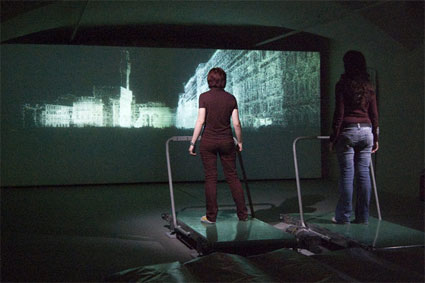
Exploded Views – Remapping Firenze
That might sound a bit like de Nijs’ famous installation Run, Motherfucker Run.
There are some similarities of course. There’s the irresistible element of risk. Don’t be fooled by the cushion which gently inflates behind you as you run…. Runners don’t have much more control on the probability of their fall as they have on its location (i did witness some “lateral falls” but they were totally benign.) I actually wonder what would happen with this installation in “risk-management” crazy Britain. But that’s another story.
Just like in RMR, the runners meets with the emptiness of the city, with an almost total absence of any human imprint on the spaces. In Remapping Firenze however, the human presence is crawling back into the city through a store of sounds registered in the city by audio designer Boris Debackere.
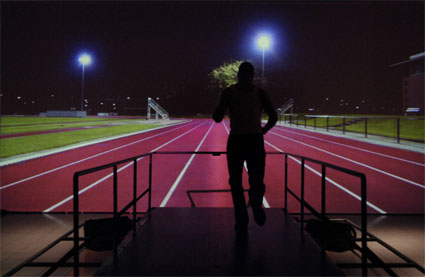
Run Mother Fucker Run
The runner can only hear the field recordings when navigating slowly through the geometry of the streets and buildings. When they accelerate, contact with human voices and noises is lost. Which touches upon one of the most impressive characteristics of Remapping Firenze: running and slowing down/stopping on the treadmill provides the public with a totally different perspective.While you adopt a gentle walking pace, the city looks real and recognizable in all its touristic cliches and beauty but once you run, you enter a new dimension, the one of modernization and globalization which Florence, just like any other city, has to live up to, no matter how fascinating the history lurking behind its thick walls can be.
RMR shows a modern city. It was in fact Rotterdam but unless you intimately know Rotterdam there was no hint of the actual location. It could have been anywhere. As its name attests, Remapping Firenze is deeply grounded in its location.
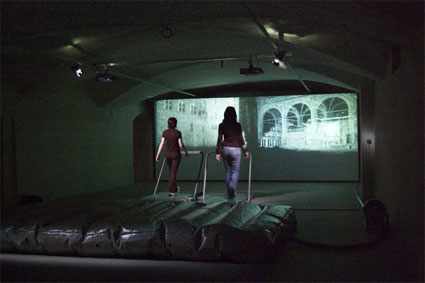
Exploded Views – Remapping Firenze
The images on the screen are part film, part computer graphics re-creation. They were created using a brand new scanning software, developed both at the Technische Universität Darmstadt and at the University of Washington. The system generates a kind of extremely detailed 3D. Its functioning is very different from the usual procedure to generate 3D images. This one works with image recognition. When a peculiar spots in the picture is recognized in different pictures, it become the reference point of the 3d meshes.
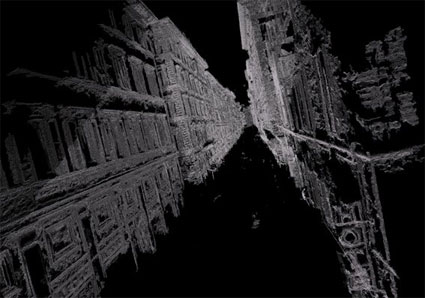
Marnix de Nijs, Rendering Exploded Views Remapping Firenze, 2008
Exploded Views – Remapping Florence was made especially for the CCCS. It’s the first of a series of works by leading international artists who have been invited to Florence to create site-specific works that reflect the diverse realities of this city’. Catch it while you can. The exhibitionis open until June 30 at Centre for Contemporary Culture Strozzina in Palazzo Strozzi, Florence.
Sordid, guilty pleasures of Sky Mall
Posted in: Uncategorized![]()
Sheer genius. I want that Bigfoot thingie. I really do. Oooh. And that giant crossoword. And all the hose holders. I’m a sucker for those.
Stan Winston RIP — hope the Predator didn’t get you.
Posted in: UncategorizedCreepy crawlies, dinosaurs and other space creatures — a moment of silence please. Stan Winston, Academy Award-winning creator of special effects, makeup and creatures has died at 62.

Best known for his work on the Terminator series, the Jurassic Park series, Aliens, the Predator series, and Edward Scissorhands — he also designed the Mr. Roboto mask for Styx’x 1983 album.
So domo arigato, Mr. Winston. I still can’t stand the fucking scribble and scratching of the face hugger skittering across the floor in the Alien Quadrology. Thanks for that bit of life-lasting horror and disgust, my friend.
Stan’s vision, creativity and monsters will be missed greatly.
Here’s just one story.
Thanks for the tip Kegger.
Mentally Tough
Posted in: Uncategorized
This spot has been around awhile, but I hadn’t seen it until this weekend. On Father’s Day, actually. Maybe it was the mood of the day, but this just jumped out of TV and slapped me around a little in terms of relevance. A great example of the right spot placed at just the right time.
Creating spots like this seems deceptively simple. Oh, hell you just take a quote from an interview Earl did a few years ago and cut together some old footage. But crafting a spot this tight and this on strategy out of found material is, in no way, as easy as it sounds. WK is just so damn good at this stuff. The Magnificent Bastards strike again.
File under: marketing to men.
Book Review – The Wrong House: The Architecture of Alfred Hitchcock
Posted in: Uncategorized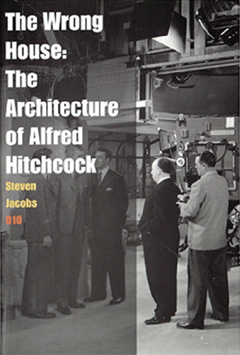 The Wrong House: The Architecture of Alfred Hitchcock, by Steven Jacobs (available on Amazon USA and UK.)
The Wrong House: The Architecture of Alfred Hitchcock, by Steven Jacobs (available on Amazon USA and UK.)
010 publishers write: In the films of Alfred Hitchcock, architecture plays an important role. Having worked as a set designer in the early 1920s, Hitchcock remained intensely concerned with the art direction of his films. In addition, the ‘master of suspense’ made some remarkable single-set films, such as Rope and Rear Window, that explicitly deal with the way the confines of the set relate to those of the architecture on screen. Spaces of confinement also turn up in the ‘Gothic plot’ of films in which the house is presented as an uncanny labyrinth and a trap. Furthermore, it became a Hitchcock hallmark to use famous monuments as the location for a climactic scene. Last but not least, Hitchcock used architectural motifs such as stairs and windows, which are closely connected to Hitchcockian narrative structures (suspense) or typical Hitchcock themes (voyeurism). Apart from dealing with these issues extensively, Steven Jacobs discusses at length a series of domestic buildings with the help of a number of reconstructed floor plans especially made for this publication.
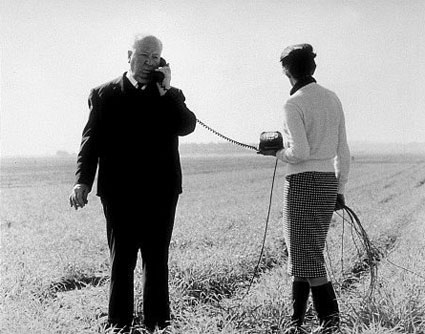
1966 “Torn Curtain,” Director Alfred Hitchcock. 1966 Universal. – Image MPTV.net
This is one dangerous book for people like me who don’t need an excuse to jump in the sofa and watch a Hitchcock movie instead of staying in front of the computer to work. Still, no matter how many books have been written about the “Master of Suspense” i never felt compelled to read any. Until this one.
Author Steven Jacobs claimed that he had written a monograph about an non-existing architect which make more sense than one might think at first sight. After all, movie directors and production designers have been known for using film sets as an intermediary to reflect on the city of the future. Having designed more models than built houses didn’t prevent architectural studio Archigram to be one of the most influential and iconic architectural studios ever. Hitchcock didn’t advance the slightest step in that direction. His art did not explore possible or futuristic architecture but remained grounded in what was available at the time of films, with a marked preference for old-style furniture and bourgeois mansions (think Victorian or his own house near Guildford.)
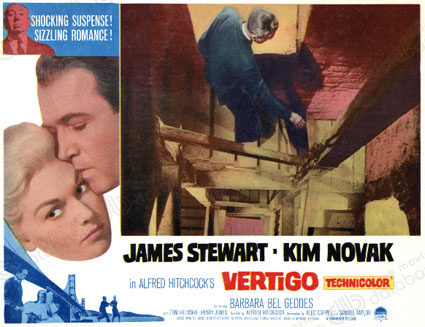
Lobby Card from Vertigo (1963 reissue). Image tcmdb
The Wrong House (a title referring to the 1956 movie The Wrong Man) is roughly made of two parts.
The first part of the book, the theoretical one, is by far the most fascinating. It explains in details how Hitchcock regarded set design as crucial element of the drama, used both domestic elements and touristic sites as protagonists in the story but also extended the architectural language to camera movements and positions, editing and other cinematographic practices.
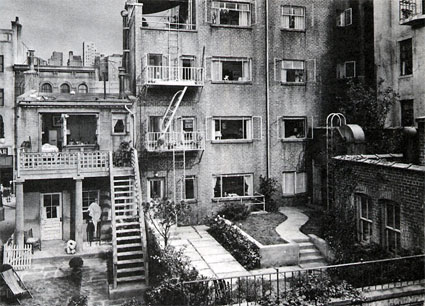
1954, Rear Window
Most of the settings for his movies were mounted in studio, where Hitchcock had total control over the shooting conditions. The most bourgeois house was often represented as a space of oppression, danger and a provider of the uncanny. The interior is stuffed and closed, keys give the viewers access to the murder room, and each step on a stair advances the denouement as much as it delays it. Other buildings, even the public ones, are not necessarily safer, perversion lurks behind motel doors, museums are made for mysterious encounters.
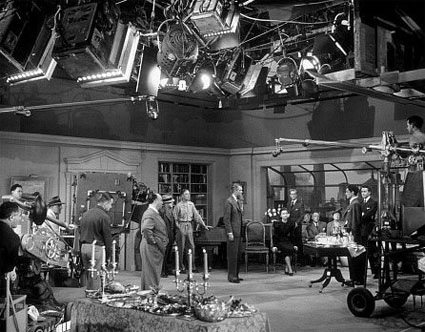
1948 James Stewart, Alfred Hitchcock, and Cast on the set of “Rope.” 1948 Warner – Image MPTV.net
In location shootings, the film director had a field day toying with crowds and playing with urban icons. The former gave him some great opportunities to insert his famous cameos. The later included the Golden Gate Bridge, the British Museum, the UN Headquarters, Mount Rushmore which are so intimately connected to the films shot there that it can be said that Hitchcock tailed tourism as much as it stimulated it.
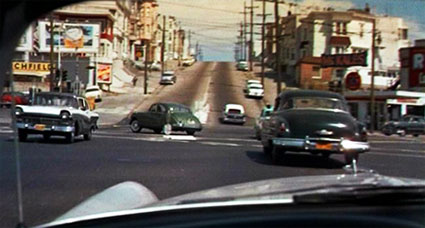
Still from Vertigo, 1958
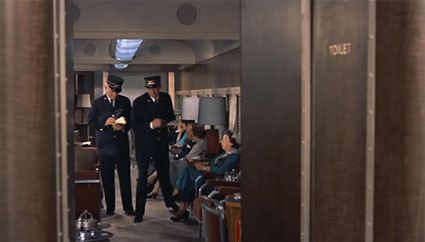
1959, North by Northwest (via filmposters)
The second part of the book, made of case studies that dissect meticulously the architecture and internal design of 26 houses from 22 different films, is a bit overwhelming. When Jacobs hasn’t been able to trace drawings of sets built in the studio, he reconstructed the floor plans of these houses, mostly on the basis of what he saw in the films. Each movie is investigated from an architectural point of view. That’s how The Balestrero House in The Wrong Man is analyzed under the perspective of Kitchen sink claustrohpobia, Bates house and motel are defined as schizoid, Sebastian house in Notorious is a place for Nazi hominess and that’s how Rebecca discovers that Manderley is in fact Bluebeard’s Castle.
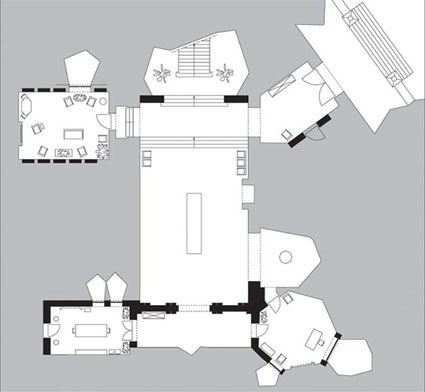
Plan of the ground floor of Manderley in the film Rebecca
I wouldn’t say that The Wrong House is an architecture book. As i am much more interested in architecture than cinema i was surprised to see how metaphorically the term “architecture” was used along its pages. But then i also like to be surprised once in a while….
Advice for everybody in the ad/marketing game.
Posted in: Uncategorized
Bill Hicks offers everyone in our business a little advice. Thanks to Armano.
Mentos & Diet Coke Booby Trap
Posted in: UncategorizedI’ve been cheating on Diet Coke with another soda lately (the worst one you can imagine) and feel just awful about it. With the amount of DC I go through, I am sure the Coca-Cola company has noticed. To make up for some of my lost volume, some of you might consider this shenanigan.
Thanks to Paul Jarret.
R.I.P. Harvey Korman
Posted in: UncategorizedToo many of these this week. Here’s to you Mr. Korman. Thanks for the laughs.
Sidenote: There’s a "thing" in theatre about "breaking character." Sure, Conway is chewing the scenery here. But the real laughs come from Korman going ahead and laughing at him. Korman knew exactly what he was doing.















